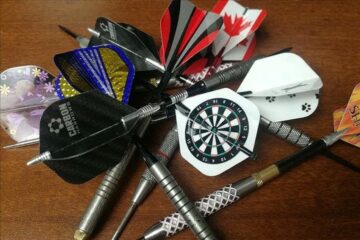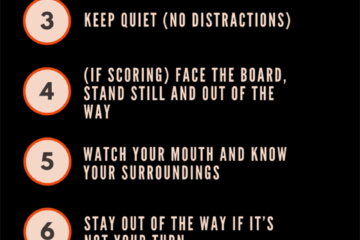Darts may land sideways due to improper grip or release technique. Improper grip or release technique is a common reason for darts to land sideways.
This can happen when the fingers are not positioned correctly on the dart or when the dart is not released with a consistent, straight motion. When the grip or release is flawed, the rotation of the dart can be affected, causing it to spin off course and land sideways.
Improving the grip and release technique can help ensure that the darts land straight and on target.

Credit: medium.com
Common Reasons For Sideways Dart Landings
Are your darts constantly landing sideways, making it difficult for you to hit your intended target? Don’t worry, you’re not alone! This frustrating problem can be caused by a few common mistakes in your grip and throwing technique.
By understanding these reasons, you can make the necessary adjustments to improve your accuracy and performance. Let’s delve into the two main causes of sideways dart landings: improper grip and incorrect throwing technique.
Improper Grip
One of the primary culprits behind sideways dart landings is an improper grip. If you don’t hold the dart correctly, it can veer off course, missing your intended mark. Here are a few aspects of grip that you should pay close attention to:
Finger Placement
Make sure your fingers are positioned correctly on the dart. Placing your fingers too far back or too close to the tip can affect the flight of the dart.
Consistency
Maintain a consistent grip throughout your throw. Changing the way you hold the dart mid-throw can lead to inconsistencies in your aim.
Pressure
Apply just enough pressure to control the dart without gripping it too tightly. Excessive force can cause the dart to wobble in the air.
Incorrect Throwing Technique
The way you throw the dart also plays a crucial role in determining its trajectory. If you have an incorrect throwing technique, your darts are more likely to land sideways. Take note of the following factors:
Release Point
Pay attention to the moment you release the dart. Releasing it too early or too late can lead to an erratic flight path.
Follow Through
It’s important to follow through with your throw. Failing to do so can disrupt the dart’s momentum and result in inconsistent landings.
Arm Alignment
Ensure that your throwing arm is aligned with your target. A misaligned arm can cause your darts to swerve off course.
Smooth Motion
Maintain a smooth and fluid throwing motion. Jerky or hurried throws often lead to inaccurate dart landings.
By addressing these common reasons for sideways dart landings, you can make significant improvements in your accuracy and overall performance. Whether it’s adjusting your grip or refining your throwing technique, practice and persistence will be essential.
Now that you have identified the potential issues, it’s time to get back to the dartboard and fine-tune your skills. So, grab your darts, make the necessary adjustments, and enjoy hitting the bullseye like never before!

Credit: www.reddit.com
Impact Of Dart Design On Landing
The design of darts has a significant impact on how they land, often causing them to land sideways. The shape and weight distribution can influence the trajectory and stability of the dart, affecting its accuracy and where it ultimately lands on the target.
When it comes to the game of darts, understanding why your darts land sideways can make a significant difference in improving your accuracy. One crucial aspect that affects the landing of your darts is the design of the dart itself. Let’s take a closer look at two key elements – weight distribution and barrel shape – and how they can impact the way your darts land.
Weight Distribution
The weight distribution of a dart plays a crucial role in its flight and landing. When the weight of a dart is unevenly distributed, it can cause the dart to tilt or wobble in the air, leading to a sideways landing. To achieve optimal balance, darts typically have a greater concentration of weight at the front or the center of the barrel.
There are various ways in which weight distribution within the dart can be achieved.
Some darts are designed with a higher density in the front half of the barrel, providing better stability during flight. This design is particularly beneficial for players who prefer a more controlled and accurate throw.
On the other hand, some darts have a more even weight distribution throughout the barrel, which can help players who prefer a smoother, natural release. However, it’s important to note that finding the right weight distribution is a matter of personal preference and may vary from player to player.
Barrel Shape
The shape of the dart’s barrel is another factor that can influence how the dart lands. Various barrel shapes have different effects on the trajectory and stability of the dart during flight. Common barrel shapes include straight barrels, tapered barrels, and scalloped barrels.
Straight barrels
Straight barrels, as the name suggests, have a uniform width from the front to the back. They provide a consistent grip and are well-suited for players who prefer a steady, controlled throw.
Tapered barrels
Tapered barrels, on the other hand, become narrower towards the front, allowing for a more streamlined release.
Scalloped barrels
Scalloped barrels have small indentations or grooves along the length of the barrel, providing improved grip and control. These barrels can influence the way the dart is held and thrown, ultimately affecting its landing.
Experimenting with different barrel shapes can help you find the one that suits your throwing technique and minimizes sideways deviations.
Improving Your Dart Throw
Having your darts land sideways can be a frustrating issue that many dart players face. It can not only affect your accuracy but also cause a loss of confidence. However, with some practice and a few adjustments, you can improve your dart throw and ensure that your darts land right on target.
Proper Grip And Release Technique
One of the most important factors in improving your dart throw is mastering the proper grip and release technique. Your grip should be relaxed, ensuring that you have a comfortable and firm hold on the dart. Avoid gripping the dart too tight, as it can restrict your release and affect your accuracy.
To determine the best grip for you, it’s essential to experiment with different styles and find the one that feels most natural. Some players prefer gripping the dart at the front, while others may find a grip closer to the back more comfortable. Find a grip that allows you to have full control and stability during the throw.
When it comes to releasing the dart, timing is crucial. The release should be smooth and fluid, and you should aim to release the dart just before your arm reaches full extension. This will ensure that the dart follows a straight trajectory and reduces the chances of it landing sideways.
Finding The Right Dart
The dart itself plays a significant role in your throw and can affect the way your darts land. It’s important to find the right dart that suits your playing style and grip. Darts come in various weights, shapes, and materials, so experimenting with different options is key to finding your perfect match.
The weight of the dart is particularly important. Heavier darts have more stability in the air, which can help reduce unwanted sideways movement. However, it’s important to strike a balance and not choose a dart that is too heavy, as it can lead to fatigue and inconsistency in your throw.
Additionally, the shape of the dart can also have an impact. Some players find that longer or shorter barrels suit their grip better and provide a more consistent release. Trying different barrel styles can help you find the one that feels most comfortable in your hand.
Practicing Aiming And Alignment
Aiming and alignment are vital aspects of improving your dart throw. To enhance your accuracy, it’s important to focus on aiming at a specific target and aligning your body accordingly.
One technique to improve your aim is to find a focal point on the dartboard, such as the bullseye or a specific segment, and consistently aim for it. This will help you develop muscle memory and fine-tune your aim over time.
When it comes to alignment, positioning your body and feet parallel to the dartboard can aid in maintaining a straight throw. Aligning yourself with the target allows for a more consistent release and reduces the chances of sideways deviation.
Regular practice is the key to honing your aiming and alignment skills. Set aside regular practice sessions to focus solely on these aspects and gradually incorporate them into your overall throwing technique.
Common Mistakes And Troubleshooting
As a dart enthusiast, there’s nothing more frustrating than consistently experiencing sideways landings. It can throw off your game and leave you questioning what might be going wrong. Fortunately, there are common mistakes that can be easily fixed, allowing you to get back on track and improve your accuracy.
Gripping The Dart Too Tightly
One of the common mistakes that can lead to sideways dart landings is gripping the dart too tightly. When you grip the dart with excessive force, it can cause you to apply uneven pressure on the dart, resulting in an unstable and erratic release. To rectify this, you need to find a balance between a firm grip and a relaxed hold.
Here’s a quick checklist to help you troubleshoot your gripping technique:
- Ensure that your grip is not too tight, allowing for a fluid release.
- Experiment with different grip styles and find one that feels comfortable for you.
- Avoid gripping the dart with only your fingertips, as this can limit control.
- Consider using finger aids or grip enhancers to improve your grip stability.
Imbalanced Dart Weight
Another factor that could be affecting your dart’s trajectory is an imbalanced dart weight. Darts come in various weights, and using mismatched darts can cause them to land sideways. Not only does this affect your aim, but it can also throw off your overall throwing technique.
To troubleshoot this issue, it’s important to:
- Ensure that all the darts you are using have the same weight.
- Experiment with different dart weights to find what works best for your throwing style.
- Inspect your darts to ensure they are not damaged or bent, as this can affect their balance.
- Consider using dart flight protectors or stabilizers to improve stability.
Misaligned Throwing Arm
Finally, a misaligned throwing arm can contribute to sidewards dart landings. When your throwing arm is not properly aligned with the dartboard, it can cause your dart to spin off-course. This misalignment can be due to poor posture or incorrect arm movement during the throw.
Here are some troubleshooting suggestions for a misaligned throwing arm:
- Practice maintaining a relaxed and upright posture while throwing.
- Ensure your throwing arm is in line with your dominant eye to optimize your aim.
- Focus on a straight and smooth arm movement to improve accuracy and minimize dart deviation.
- Experiment with minor adjustments to find the optimal throwing alignment for your body.
Practice And Consistency
Just like with any other skill, practice and consistency are key to improving your dart flight. Here’s how you can enhance your skills through practice:
- Devote regular time to practice your throwing technique.
- Focus on throwing with a smooth and fluid motion rather than rushing your throw.
- Develop a consistent pre-shot routine that includes the same body position, aim, and release point.
Wrapping Up
Landing darts sideways can be frustrating for any player, but understanding the common reasons behind this issue can lead to improved accuracy and success. Factors such as grip, technique, stance, and equipment quality can all contribute to this problem. By addressing these areas and making necessary adjustments, players can greatly enhance their dart throwing skills.
So, don’t be discouraged, keep practicing and taking note of these tips to improve your dart game!
FAQs
How Do You Keep Darts Straight?
To keep darts straight, follow these tips: 1. Maintain a steady grip and stance while throwing. 2. Align your dominant eye with the target. 3. Ensure a smooth release without unnecessary movements. 4. Practice regularly to improve accuracy and consistency.
Why Are My Darts So Inconsistent?
Your darts may be inconsistent due to factors such as grip, throw, or technique. Practice and experimenting with different darts can help improve consistency.
Why Do My Darts Wobble In The Air?
Your darts may wobble in the air due to several factors, such as improper grip, unbalanced weight distribution, or flawed throwing technique. Ensure proper grip, practice throwing techniques, and consider using well-balanced darts to improve accuracy and reduce wobbling in the air.
Why Do My Darts Go To The Right?
Your darts may be going to the right due to a few reasons such as improper hand position, incorrect aiming, or a misaligned throw. Adjusting your grip, focusing on your target, and practicing your release can help improve accuracy.



